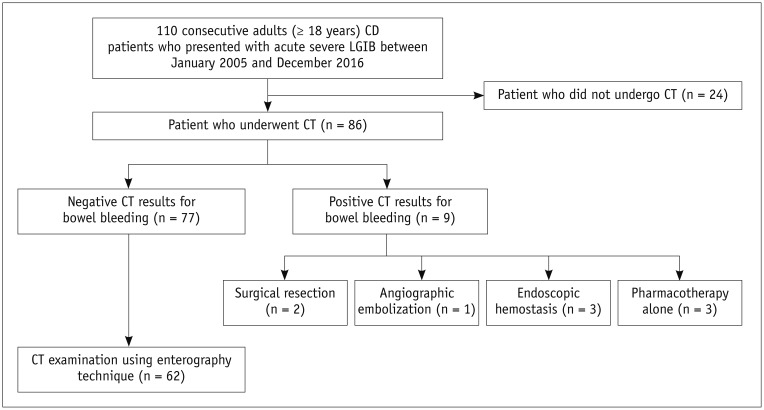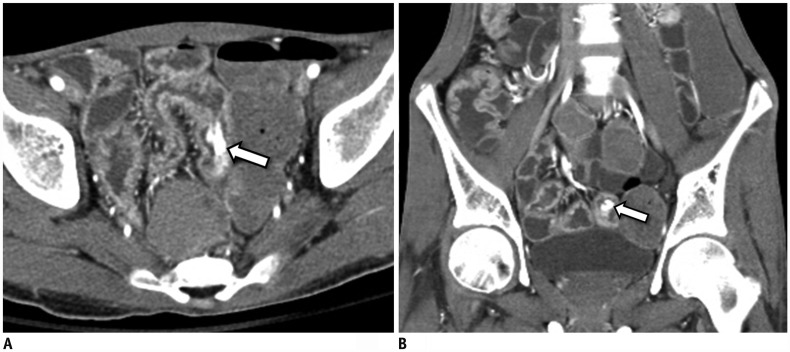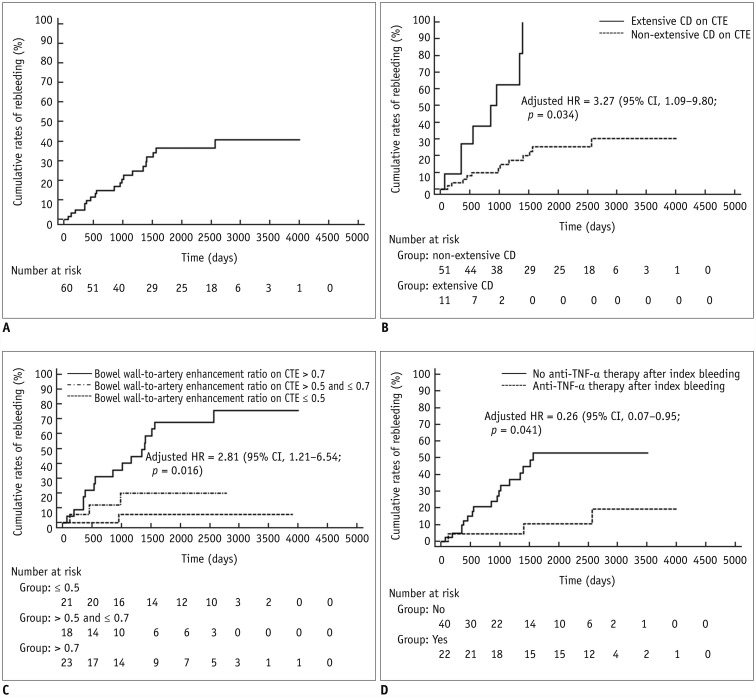Korean J Radiol.
2018 Dec;19(6):1089-1098. 10.3348/kjr.2018.19.6.1089.
Diagnostic Value of Computed Tomography in Crohn's Disease Patients Presenting with Acute Severe Lower Gastrointestinal Bleeding
- Affiliations
-
- 1Department of Radiology and the Research Institute of Radiology, University of Ulsan College of Medicine, Asan Medical Center, Seoul 05505, Korea. parksh.radiology@gmail.com
- 2Department of Gastroenterology and Inflammatory Bowel Disease Center, University of Ulsan College of Medicine, Asan Medical Center, Seoul 05505, Korea.
- KMID: 2424848
- DOI: http://doi.org/10.3348/kjr.2018.19.6.1089
Abstract
OBJECTIVE
To investigate the diagnostic yield of contrast-enhanced computed tomography (CT) in Crohn's disease (CD) patients presenting with acute severe lower gastrointestinal bleeding (LGIB), and the role of CT in predicting the risk of rebleeding.
MATERIALS AND METHODS
A consecutive series of 110 CD patients presenting with acute severe LGIB between 2005 and 2016 were analyzed. Among them, 86 patients who had undergone contrast-enhanced CT constituted the study cohort. The diagnostic yield of CT for detecting contrast extravasation was obtained for the entire cohort and compared between different CT techniques. In a subgroup of 62 patients who had undergone CT enterography (CTE) and showed a negative result for extravasation on CTE, the association between various clinical and CTE parameters and the risk of rebleeding during subsequent follow-up was investigated using Cox regression analysis.
RESULTS
The diagnostic yield of CT was 10.5% (9 of 86 patients). The yield did not significantly differ between single-phase and multiphase examinations (p > 0.999), or between non-enterographic CT and CTE (p = 0.388). Extensive CD (adjusted hazard ratio [HR], 3.27; 95% confidence interval [CI], 1.09-9.80; p = 0.034) and bowel wall-to-artery enhancement ratio (adjusted HR, 2.81; 95% CI, 1.21-6.54; p = 0.016) were significantly independently associated with increased rebleeding risks, whereas anti-tumor necrosis factor-α therapy after the bleeding independently decreased the risk of rebleeding (adjusted HR, 0.26; 95% CI, 0.07-0.95; p = 0.041).
CONCLUSION
The diagnostic yield of contrast-enhanced CT was not high in CD patients presenting with acute severe LGIB. Nevertheless, even a negative CTE may be beneficial as it can help predict the risk of later rebleeding.
Keyword
MeSH Terms
Figure
Reference
-
1. Li G, Ren J, Wang G, Wu Q, Gu G, Ren H, et al. Prevalence and risk factors of acute lower gastrointestinal bleeding in Crohn disease. Medicine (Baltimore). 2015; 94:e804. PMID: 25984665.
Article2. Kim KJ, Han BJ, Yang SK, Na SY, Park SK, Boo SJ, et al. Risk factors and outcome of acute severe lower gastrointestinal bleeding in Crohn's disease. Dig Liver Dis. 2012; 44:723–728. PMID: 22497905.
Article3. Kostka R, Lukás M. Massive, life-threatening bleeding in Crohn's disease. Acta Chir Belg. 2005; 105:168–174. PMID: 15906908.
Article4. Veroux M, Angriman I, Ruffolo C, Barollo M, Buffone A, Madia C, et al. Severe gastrointestinal bleeding in Crohn's disease. Ann Ital Chir. 2003; 74:213–215. discussion 216. PMID: 14577120.5. Pardi DS, Loftus EV Jr, Tremaine WJ, Sandborn WJ, Alexander GL, Balm RK, et al. Acute major gastrointestinal hemorrhage in inflammatory bowel disease. Gastrointest Endosc. 1999; 49:153–157. PMID: 9925691.
Article6. Driver CP, Anderson DN, Keenan RA. Massive intestinal bleeding in association with Crohn's disease. J R Coll Surg Edinb. 1996; 41:152–154. PMID: 8763176.7. Cirocco WC, Reilly JC, Rusin LC. Life-threatening hemorrhage and exsanguination from Crohn's disease. Report of four cases. Dis Colon Rectum. 1995; 38:85–95. PMID: 7813353.8. Robert JR, Sachar DB, Greenstein AJ. Severe gastrointestinal hemorrhage in Crohn's disease. Ann Surg. 1991; 213:207–211. PMID: 1998401.
Article9. Belaiche J, Louis E, D'Haens G, Cabooter M, Naegels S, De Vos M, et al. Acute lower gastrointestinal bleeding in Crohn's disease: characteristics of a unique series of 34 patients. Belgian IBD Research Group. Am J Gastroenterol. 1999; 94:2177–2181. PMID: 10445546.10. Cheifetz AS, Kornbluth AA, Legnani P, Schmelkin I, Brown A, Lichtiger S, et al. The risk of retention of the capsule endoscope in patients with known or suspected Crohn's disease. Am J Gastroenterol. 2006; 101:2218–2222. PMID: 16848804.
Article11. Gerson LB, Fidler JL, Cave DR, Leighton JA. ACG clinical guideline: diagnosis and management of small bowel bleeding. Am J Gastroenterol. 2015; 110:1265–1287. quiz 1288. PMID: 26303132.
Article12. Park SH, Ye BD, Lee TY, Fletcher JG. Computed tomography and magnetic resonance small bowel enterography: current status and future trends focusing on Crohn's disease. Gastroenterol Clin North Am. 2018; 47:475–499. PMID: 30115433.13. Park SH, Yang SK, Park SK, Kim JW, Yang DH, Jung KW, et al. Long-term prognosis of crohn’s disease and its temporal change between 1981 and 2012: a hospital-based cohort study from Korea. Inflamm Bowel Dis. 2014; 20:488–494. PMID: 24412992.14. Lennard-Jones JE. Classification of inflammatory bowel disease. Scand J Gastroenterol Suppl. 1989; 170:2–6. discussion 16-19. PMID: 2617184.
Article15. Van Assche G, Dignass A, Panes J, Beaugerie L, Karagiannis J, Allez M, et al. European Crohn's and Colitis Organisation (ECCO). The second European evidence-based consensus on the diagnosis and management of Crohn's disease: definitions and diagnosis. J Crohns Colitis. 2010; 4:7–27. PMID: 21122488.
Article16. Satsangi J, Silverberg MS, Vermeire S, Colombel JF. The Montreal classification of inflammatory bowel disease: controversies, consensus, and implications. Gut. 2006; 55:749–753. PMID: 16698746.
Article17. Gomollón F, Dignass A, Annese V, Tilg H, Van Assche G, Lindsay JO, et al. ECCO. 3rd European evidence-based consensus on the diagnosis and management of Crohn's disease 2016: part 1: diagnosis and medical management. J Crohns Colitis. 2017; 11:3–25. PMID: 27660341.
Article18. Baker ME, Walter J, Obuchowski NA, Achkar JP, Einstein D, Veniero JC, et al. Mural attenuation in normal small bowel and active inflammatory Crohn's disease on CT enterography: location, absolute attenuation, relative attenuation, and the effect of wall thickness. AJR Am J Roentgenol. 2009; 192:417–423. PMID: 19155404.
Article19. Kim C, Park SH, Yang SK, Ye BD, Park SH, Lee JS, et al. Endoscopic complete remission of Crohn disease after anti-tumor necrosis factor-α therapy: CT enterographic findings and their clinical implications. AJR Am J Roentgenol. 2016; 206:1208–1216. PMID: 26998628.
Article20. Strate LL, Naumann CR. The role of colonoscopy and radiological procedures in the management of acute lower intestinal bleeding. Clin Gastroenterol Hepatol. 2010; 8:333–343. quiz e44. PMID: 20036757.
Article21. Huprich JE, Fletcher JG, Fidler JL, Alexander JA, Guimarães LS, Siddiki HA, et al. Prospective blinded comparison of wireless capsule endoscopy and multiphase CT enterography in obscure gastrointestinal bleeding. Radiology. 2011; 260:744–751. PMID: 21642417.
Article22. Lee SS, Oh TS, Kim HJ, Chung JW, Park SH, Kim AY, et al. Obscure gastrointestinal bleeding: diagnostic performance of multidetector CT enterography. Radiology. 2011; 259:739–748. PMID: 21460027.
Article23. Shin JK, Cheon JH, Lim JS, Park JJ, Moon CM, Jeon SM, et al. Long-term outcomes of obscure gastrointestinal bleeding after CT enterography: does negative CT enterography predict lower long-term rebleeding rate? J Gastroenterol Hepatol. 2011; 26:901–907. PMID: 21073673.
Article24. Soto JA, Park SH, Fletcher JG, Fidler JL. Gastrointestinal hemorrhage: evaluation with MDCT. Abdom Imaging. 2015; 40:993–1009. PMID: 25637128.
Article25. Korzenik JR. Massive lower gastrointestinal hemorrhage in Crohn's disease. Curr Treat Options Gastroenterol. 2000; 3:211–216. PMID: 11097738.
Article26. Belaiche J, Louis E. Severe lower gastrointestinal bleeding in Crohn's disease: successful control with infliximab. Am J Gastroenterol. 2002; 97:3210–3211. PMID: 12492221.
Article27. Papi C, Gili L, Tarquini M, Antonelli G, Capurso L. Infliximab for severe recurrent Crohn's disease presenting with massive gastrointestinal hemorrhage. J Clin Gastroenterol. 2003; 36:238–241. PMID: 12590236.
Article28. Tsujikawa T, Nezu R, Andoh A, Saotome T, Araki Y, Ishizuka Y, et al. Inflixmab as a possible treatment for the hemorrhagic type of Crohn's disease. J Gastroenterol. 2004; 39:284–287. PMID: 15065007.
Article29. Meyer MM, Levine EJ. Acute hemorrhagic Crohn's disease controlled with infliximab. Inflamm Bowel Dis. 2009; 15:1456–1457. PMID: 19107774.
Article30. Ando Y, Matsushita M, Kawamata S, Shimatani M, Fujii T, Okazaki K. Infliximab for severe gastrointestinal bleeding in Crohn's disease. Inflamm Bowel Dis. 2009; 15:483–484. PMID: 18668673.
Article31. Julián Gómez L, Atienza R, Barrio J, Gil P, Gómez de la Cuesta S, Pinto P, et al. [Infliximab treatment of severe bleeding complicating Crohn's disease]. Rev Esp Enferm Dig. 2010; 102:57–58. PMID: 20187687.32. Alcalde Vargas A, Justiniano JM, Carnerero EL, Salado CT, Domingo IG, Galán JL. [Utility of infliximab therapy in severe enterorrhagia associated with Crohn's disease. Report of three cases]. Gastroenterol Hepatol. 2011; 34:24–28. PMID: 21168243.33. Aniwan S, Eakpongpaisit S, Imraporn B, Amornsawadwatana S, Rerknimitr R. Infliximab stopped severe gastrointestinal bleeding in Crohn's disease. World J Gastroenterol. 2012; 18:2730–2734. PMID: 22690085.
Article34. D'haens G, Van Deventer S, Van Hogezand R, Chalmers D, Kothe C, Baert F, et al. Endoscopic and histological healing with infliximab anti-tumor necrosis factor antibodies in Crohn's disease: a European multicenter trial. Gastroenterology. 1999; 116:1029–1034. PMID: 10220494.
- Full Text Links
- Actions
-
Cited
- CITED
-
- Close
- Share
- Similar articles
-
- Role of Multi-detector Row Computed Tomography for Localization of Acute Lower Gastrointestinal Bleeding
- Clinical assessment and treatment algorithm for lower gastrointestinal bleeding
- A Case of Successful Colonoscopic Treatment of Acute Appendiceal Bleeding by Endoclips
- Role of computed tomography angiography for acute gastrointestinal bleeding
- Life-Threatening Lower Gastrointestinal Hemorrhage in Pediatric Crohn's Disease




